A Texture-Based Land Cover Classification for the Delineation of a Shifting Cultivation Landscape in the Lao PDR Using Landscape Metrics
Abstract
:1. Introduction
- To determine the influence of the texture measures on the accuracy of an object-oriented land cover classification in a mountainous region;
- To assess the potential of such a classification to delineate the landscapes where shifting cultivation is practiced using landscape metrics.
2. Study Site
3. Data
3.1. Satellite Imagery
3.2. Topographic Data
3.3. Training Data
4. Approach and Methodology
4.1. Image Segmentation and Classification
4.2. Delineation of the Shifting Cultivation Landscape
- The overall accuracy of the land cover classification was 89% and, thus, according to Shao and Wu [38], acceptable (but close to high, as the threshold is at 90%);
- The error balance between user and producer accuracy was acceptable, as the difference between the two was not bigger than 15 for all the classes;
- The reliability of the spatial resolution criterion was high. As we show in the following section, the minimum mapping unit of the landscape metrics exceeded two times the pixel size of the remotely sensed data.
- Ratio GS/BA: 2 to 11
- Ratio YF/GS: 1 to 12
- Ratio YF/BA: 3 to 50
- Ratio GS/BA: the minimum threshold was set at 3, and the upper limit of this ratio was set at 11;
- Ratio YF/GS: the minimum was set at 0.5, and the maximum value was set at 12;
- Ratio YF/BA: the minimum was set at 2, and the upper limit was set at 50.
5. Results
5.1. Image Classification
5.2. Delineation of the Shifting Cultivation Landscape
6. Discussion
7. Conclusions
Acknowledgments
Conflict of Interest
References
- De Rouw, A.; Soulilad, B.; Phanthavong, K.; Dupin, B. The Adaptation of Upland Rice Cropping to Ever-shorter Fallow Periods and Its Limit. In Poverty Reduction and Shifting Cultivation Stabilisation in the Uplands of Lao PDR; Bouahom, B., Glendinning, A., Nilsson, S., Victor, M., Eds.; NAFRI: Vientiane, Lao PDR, 2005; pp. 139–148. [Google Scholar]
- Hett, C.; Castella, J.C.; Heinimann, A.; Messerli, P.; Pfund, J.L. A landscape mosaics approach for characterizing swidden systems from a REDD plus perspective. Appl. Geogr 2012, 32, 608–618. [Google Scholar]
- Inoue, Y.; Kiyono, Y.; Asai, H.; Ochiai, Y.; Qi, J.; Olioso, A.; Shiraiwa, T.; Horie, T.; Saito, K.; Dounagsavanh, L. Assessing land-use and carbon stock in slash-and-burn ecosystems in tropical mountain of Laos based on time-series satellite images. Int. J. Appl. Earth Obs. Geoinf 2010, 12, 287–297. [Google Scholar]
- Mertz, O.; Padoch, C.; Fox, J.; Cramb, R.; Leisz, S.; Lam, N.; Vien, T. Swidden change in southeast Asia: Understanding causes and consequences. Hum. Ecol 2009, 37, 259–264. [Google Scholar]
- Dorren, L.K.A.; Maier, B.; Seijmonsbergen, A.C. Improved Landsat-based forest mapping in steep mountainous terrain using object-based classification. For. Ecol. Manag 2003, 183, 31–46. [Google Scholar]
- Gustafson, E.J. Quantifying landscape spatial pattern: What is the state of the art? Ecosystems 1998, 1, 143–156. [Google Scholar]
- Li, H.; Wu, J. Use and misuse of landscape indices. Landsc. Ecol 2004, 19, 389–399. [Google Scholar]
- Heinimann, A. Patterns of Land Cover Change in the Lower Mekong Basin: The Relevance of Mesoscale Approaches, Ph.D. Dissertation, University of Bern, Bern, Switzerland. 2006.
- Hurni, K.; Hett, C.; Heinimann, A.; Messerli, P.; Wiesmann, U. Dynamics of shifting cultivation landscapes in Northern Lao PDR between 2000 and 2009 based on an analysis of MODIS time series and landsat images. Hum. Ecol 2013, 41, 21–36. [Google Scholar]
- Inoue, Y.; Qi, J.; Olioso, A.; Kiyono, Y.; Horie, T.; Asai, H.; Saito, K.; Ochiai, Y.; Shiraiwa, T.; Douangsavanh, L. Traceability of slash-and-burn land-use history using optical satellite sensor imagery: A basis for chronosequential assessment of ecosystem carbon stock in Laos. Int. J. Remote Sens 2007, 28, 5641–5647. [Google Scholar]
- Yamamoto, Y.; Oberthür, T.; Lefroy, R. Spatial identification by satellite imagery of the crop–fallow rotation cycle in northern Laos. Environ. Dev. Sustain 2009, 11, 639–654. [Google Scholar]
- Messerli, P.; Heinimann, A.; Epprecht, M. Finding homogeneity in heterogeneity—A new approach to quantifying landscape mosaics developed for the Lao PDR. Hum. Ecol 2009, 37, 291–304. [Google Scholar]
- Cihlar, J.; Jansen, L.J.M. From land cover to land use: A methodology for efficient land use mapping over large areas. Prof. Geogr 2001, 53, 275–289. [Google Scholar]
- Martínez, S.; Mollicone, D. From land cover to land use: A methodology to assess land use from remote sensing data. Remote Sens 2012, 4, 1024–1045. [Google Scholar]
- Fensham, R.J.; Fairfax, R.J. Effect of photoscale, interpreter bias and land type on woody crown-cover estimates from aerial photography. Austr. J. Bot 2007, 55, 457–463. [Google Scholar]
- McGwire, K.C. Analyst variability in labeling of unsupervised classifications. Photogramm. Eng. Remote Sensing 1992, 58, 5. [Google Scholar]
- Asner, G.P.; Warner, A.S. Canopy shadow in IKONOS satellite observations of tropical forests and savannas. Remote Sens. Environ 2003, 87, 521–533. [Google Scholar]
- GOFC-GOLD, A Sourcebook of Methods and Procedures for Monitoring and Reporting Anthropogenic Geenhouse Gas Emissions and Removals Caused by Deforestation, Gains and Losses of Carbon Stocks in Forests Remaining Forests and Forestation; GOFC-GOLD Report Version COP17-1; GOFC-GOLD Project Office, Natural Resources Canda: Edmonton, AB, Canada, 2011; p. 203.
- Helmer, E.H.; Brown, S.; Cohen, W.B. Mapping montane tropical forest successional stage and land use with multi-date Landsat imagery. Int. J. Remote Sens 2000, 21, 2163–2183. [Google Scholar]
- Franklin, S.E.; Hall, R.J.; Moskal, L.M.; Maudie, A.J.; Lavigne, M.B. Incorporating texture into classification of forest species composition from airborne multispectral images. Int. J. Remote Sens 2000, 21, 61–79. [Google Scholar]
- Eckert, S. Improved forest biomass and carbon estimations using texture measures from WorldView-2 Satellite data. Remote Sens 2012, 4, 810–829. [Google Scholar]
- Fuchs, H.; Magdon, P.; Kleinn, C.; Flessa, H. Estimating aboveground carbon in a catchment of the Siberian forest tundra: Combining satellite imagery and field inventory. Remote Sens. Environ 2009, 113, 518–531. [Google Scholar]
- Kim, M.; Madden, M.; Warner, T.A. Forest type mapping using object-specific texture measures from multispectral ikonos imagery: Segmentation quality and image classification issues. Photogramm. Eng. Remote Sens 2009, 75, 819–829. [Google Scholar]
- Lu, D. Aboveground biomass estimation using Landsat TM data in the Brazilian Amazon. Int. J. Remote Sens 2005, 26, 2509–2525. [Google Scholar]
- Sarker, L.R.; Nichol, J.E. Improved forest biomass estimates using ALOS AVNIR-2 texture indices. Remote Sens. Environ 2011, 115, 968–977. [Google Scholar]
- Messerli, P.; Heinimann, A.; Epprecht, M.; Phonesaly, S.; Thiraka, C.; Minot, N. Socio-Economic Atlas of the Lao PDR—An Analysis Based on the 2005 Population and Housing Census; Geographica Bernensia: Bern, Switzerland and Vientiane, Lao PDR, 2008; p. 139. [Google Scholar]
- Fujita, Y.; Phanvilay, K. Land and forest allocation in Lao People’s Democratic Republic: Comparison of case studies from community-based natural resource management research. Soc. Nat. Resour 2008, 21, 120–133. [Google Scholar]
- Saito, K.; Linquist, B.; Keobualapha, B.; Shiraiwa, T.; Horie, T. Farmers’ knowledge of soils in relation to cropping practices: A case study of farmers in upland rice based slash-and-burn systems of northern Laos. Geoderma 2006, 136, 64–74. [Google Scholar]
- Fujisaka, S. A diagnostic survey of shifting cultivation in northern Laos: Targeting research to improve sustainability and productivity. Agrofor. Syst 1991, 13, 95–109. [Google Scholar]
- TABI The Agrobiodiversity Initiative in the Lao PDR. Available online: http://www.tabi.la/en/maps/phonexay-village-level-maps.html (accessed on 7 November 2012).
- Nichol, J.; Hang, L.K. The influence of DEM accuracy, on topographic correction of Ikonos satellite images. Photogramm. Eng. Remote Sensing 2008, 74, 47–53. [Google Scholar]
- Bahadur, K.C.; K. Improving landsat and IRS image classification: Evaluation of unsupervised and supervised classification through band ratios and DEM in a mountainous landscape in Nepal. Remote Sens 2009, 1, 1257–1272. [Google Scholar]
- Trimble Documentation. In eCogntion Developer 8.7 User Guide; Trimble Germany GMBH: München, Germany, 2011; p. 250.
- Kindu, M.; Schneider, T.; Teketay, D.; Knoke, T. Land use/land cover change analysis using object-based classification approach in Munessa-Shashemene Landscape of the Ethiopian Highlands. Remote Sensing 2013, 5, 2411–2435. [Google Scholar]
- Kim, M.; Madden, M.; Warner, T. Estimation of Optimal Image Object Size for the Segmentation of Forest Stands with Multispectral IKONOS Imagery. In Object-Based Image Analysis; Blaschke, T., Lang, S., Hay, G.J., Eds.; Springer: Berlin, Heidelberg, Germany, 2008; pp. 291–307. [Google Scholar]
- Haralick, R.M.; Shanmugam, K.; Dinstein, I.H. Textural features for image classification. IEEE Trans. Syst. Man Cybern 1973, 3, 610–621. [Google Scholar]
- Robichaud, W.G.; Sinclair, A.R.E.; Odarkor-Lanquaye, N.; Klinkenberg, B. Stable forest cover under increasing populations of swidden cultivators in central Laos: The roles of intrinsic culture and extrinsic wildlife trade. Ecol. Soc 2009, 14, 33. [Google Scholar]
- Shao, G.; Wu, J. On the accuracy of landscape pattern analysis using remote sensing data. Landsc. Ecol 2008, 23, 505–511. [Google Scholar]
- Ruthenberg, H. Farming Systems in the Tropics; Clarendon Press: Oxford, UK, 1971; p. 313. [Google Scholar]
- Raufu, M.O. Pattern of land use among selected crop farmers in Osun State. Res. J. Soil Water Manag 2010, 1, 4. [Google Scholar]
- Nair, P.K.R. An Introduction to Agroforestry; Kluwer Academic Publishers: Dordrecht, The Netherlands, 1993; p. 499. [Google Scholar]
- Yu, Q.; Gong, P.; Clinton, N.; Biging, G.; Kelly, M.; Schirokauer, D. Object-based detailed vegetation classification. with airborne high spatial resolution remote sensing imagery. Photogramm. Eng. Remote Sensing 2006, 72, 799–811. [Google Scholar]
- Pan, X.-Z.; Uchida, S.; Liang, Y.; Hirano, A.; Sun, B. Discriminating different landuse types by using multitemporal NDXI in a rice planting area. Int. J. Remote Sens 2010, 31, 585–596. [Google Scholar]
- Thenkabail, P.S. Characterization of the alternative to slash-and-burn benchmark research area representing the Congolese rainforests of Africa using near-real-time SPOT HRV data. Int. J. Remote Sens 1999, 20, 839–877. [Google Scholar]
- Schmidt-Vogt, D.; Leisz, S.; Mertz, O.; Heinimann, A.; Thiha, T.; Messerli, P.; Epprecht, M.; Cu, P.; Chi, V.; Hardiono, M.; et al. An assessment of trends in the extent of Swidden in Southeast Asia. Hum. Ecol 2009, 37, 269–280. [Google Scholar]
- Heinimann, A.; Hett, C.; Hurni, K.; Messerli, P.; Epprecht, M.; Jørgensen, L.; Breu, T. Socio-economic perspectives on shifting cultivation landscapes in Northern Laos. Hum. Ecol 2013, 41, 51–62. [Google Scholar]
- Padoch, C.; Coffey, K.; Mertz, O.; Leisz, S.J.; Fox, J.; Wadley, R.L. The demise of Swidden in Southeast Asia? Local realities and regional ambiguities. Dan. J. Geogr 2007, 107, 29–41. [Google Scholar]
- Seidenberg, C.; Mertz, O.; Kias, M.B. Fallow, labour and livelihood in shifting cultivation: Implications for deforestation in northern Lao PDR. Geogr. Tidsskr 2003, 103, 10. [Google Scholar]
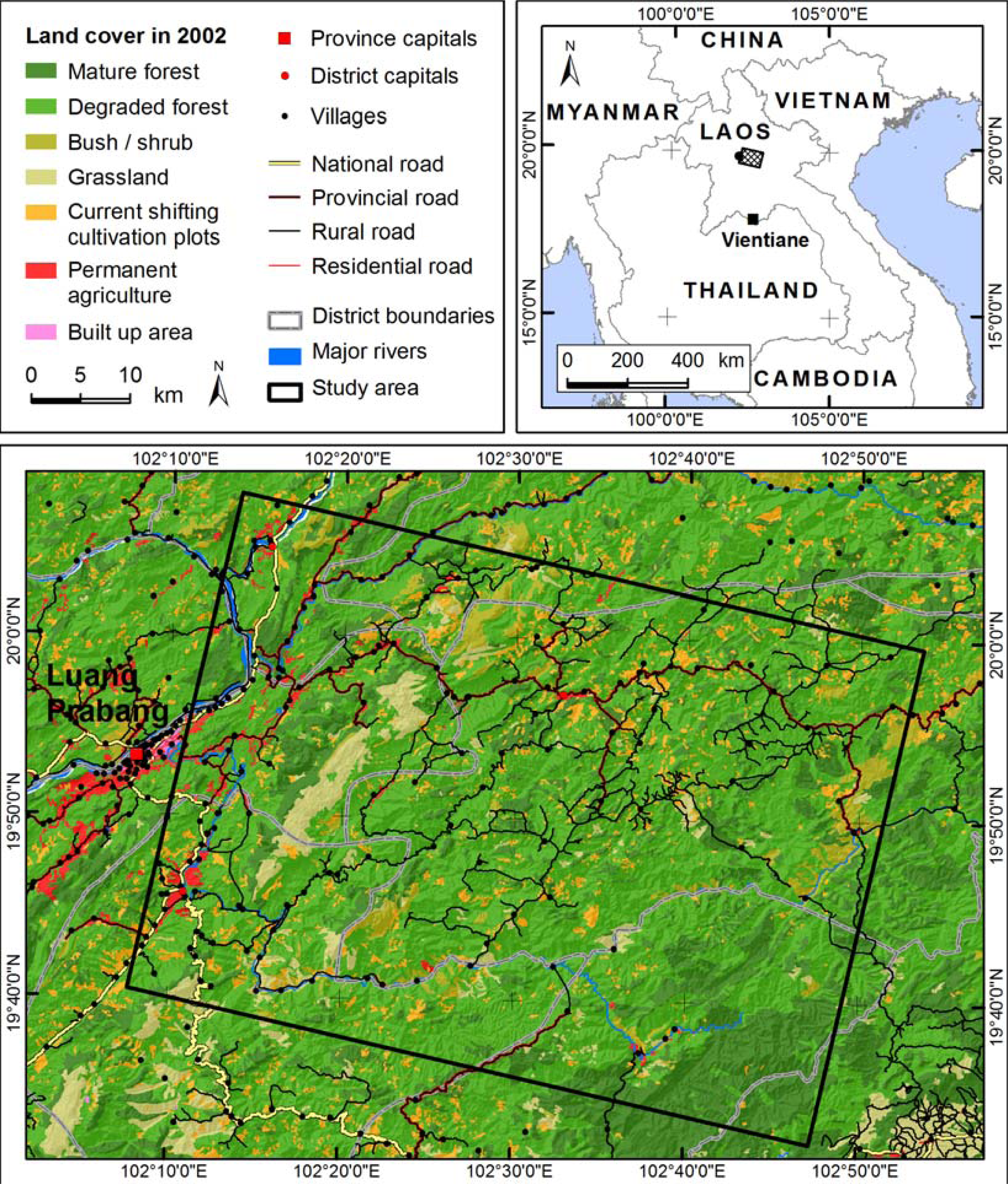
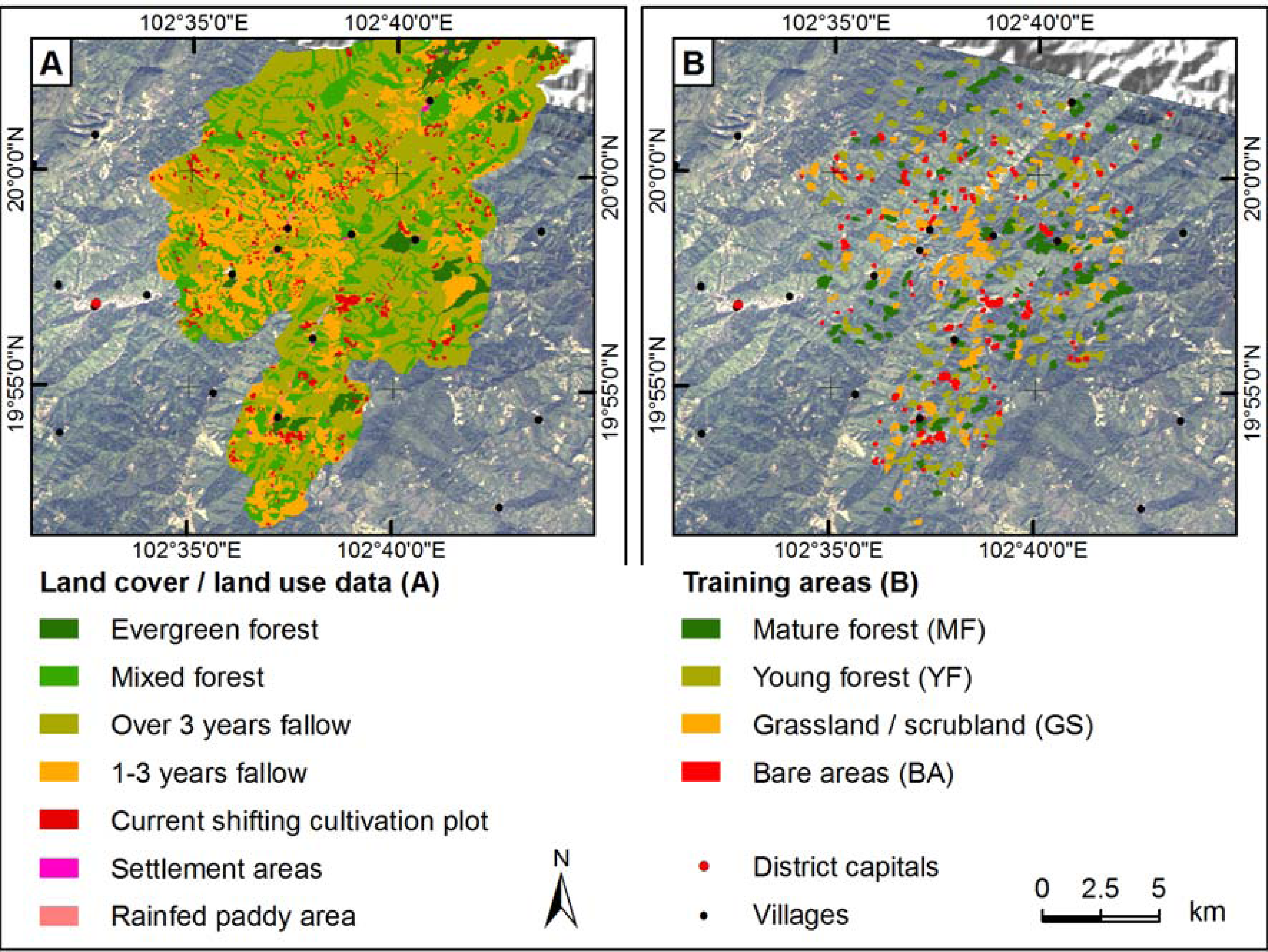
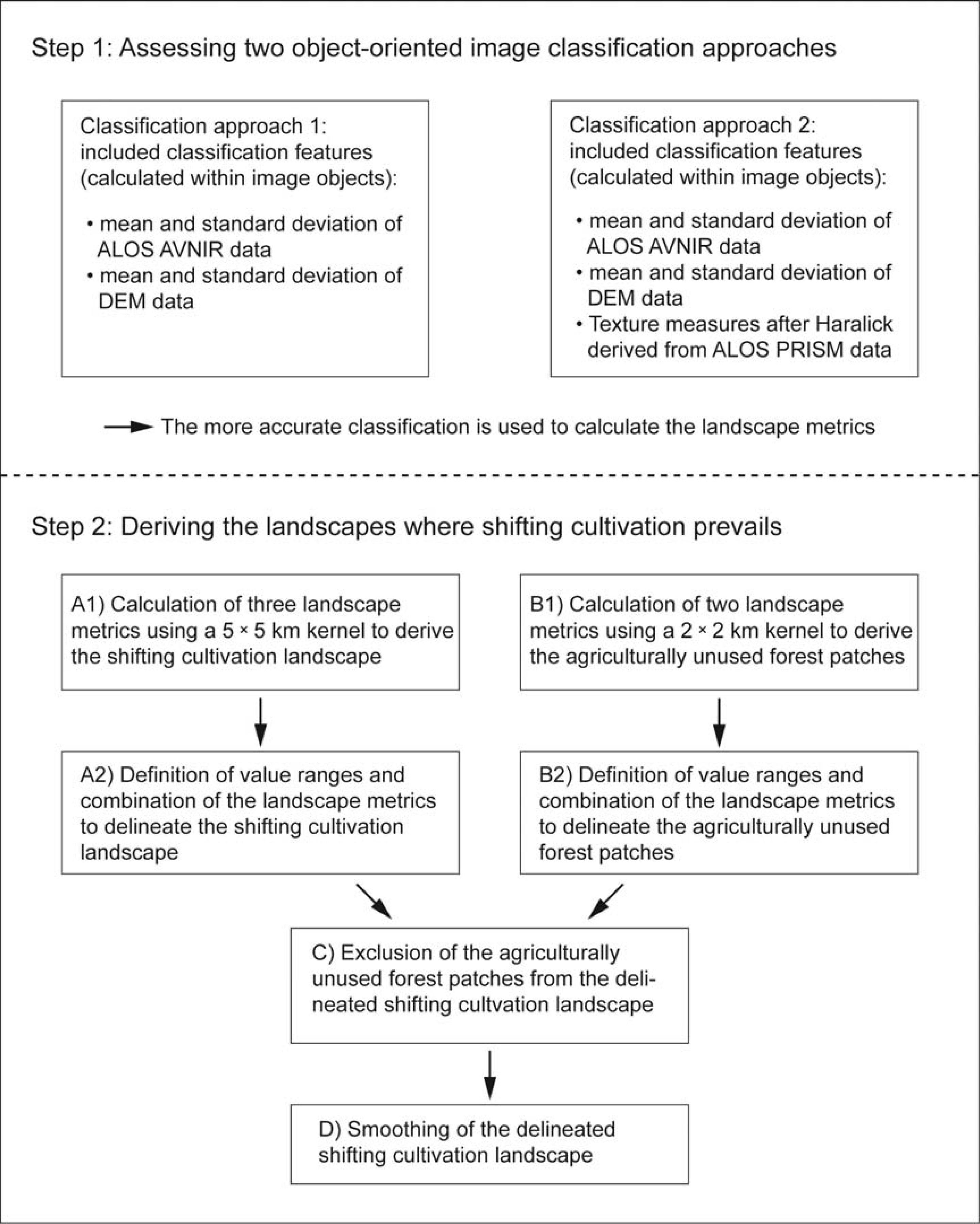
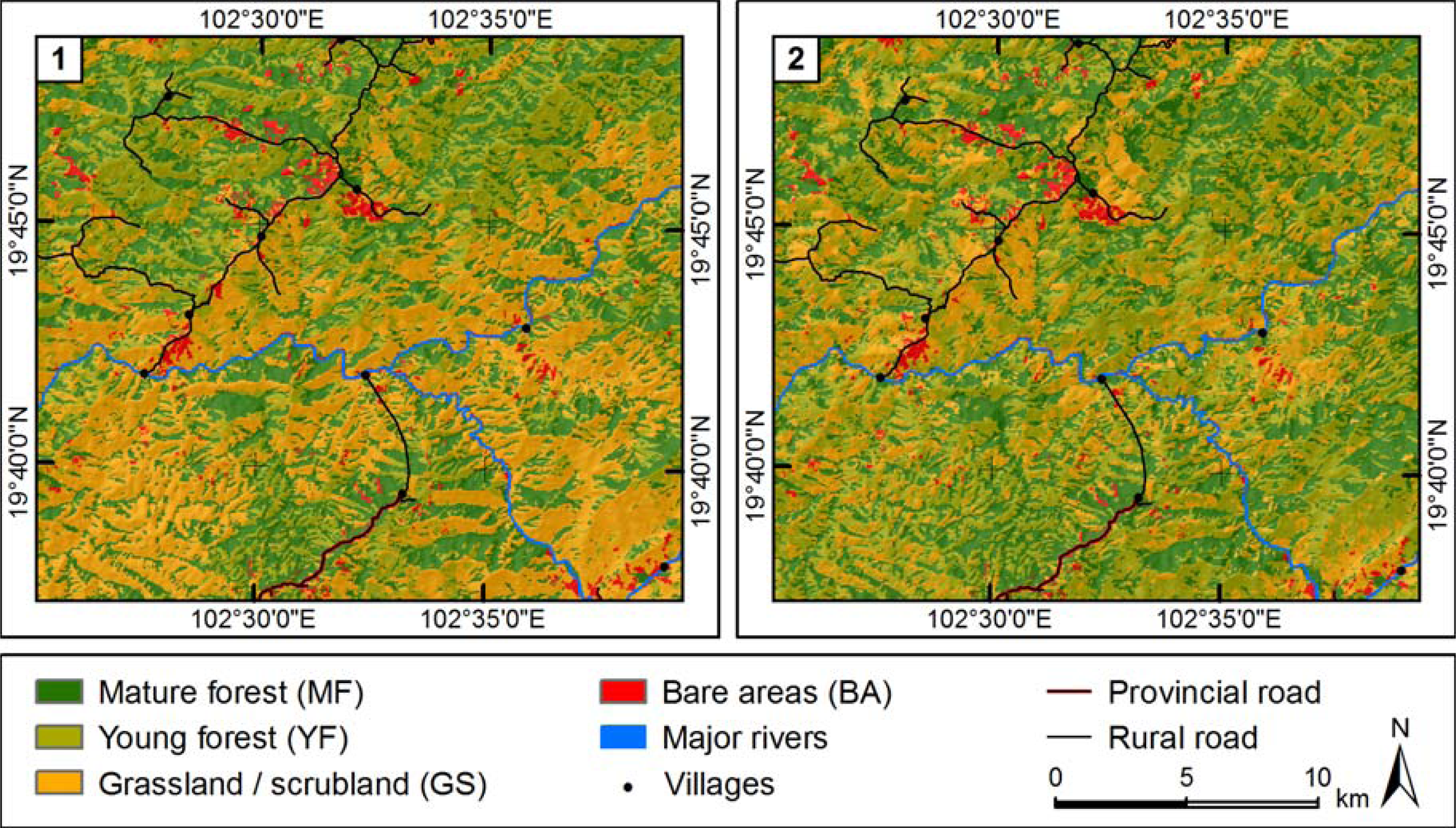
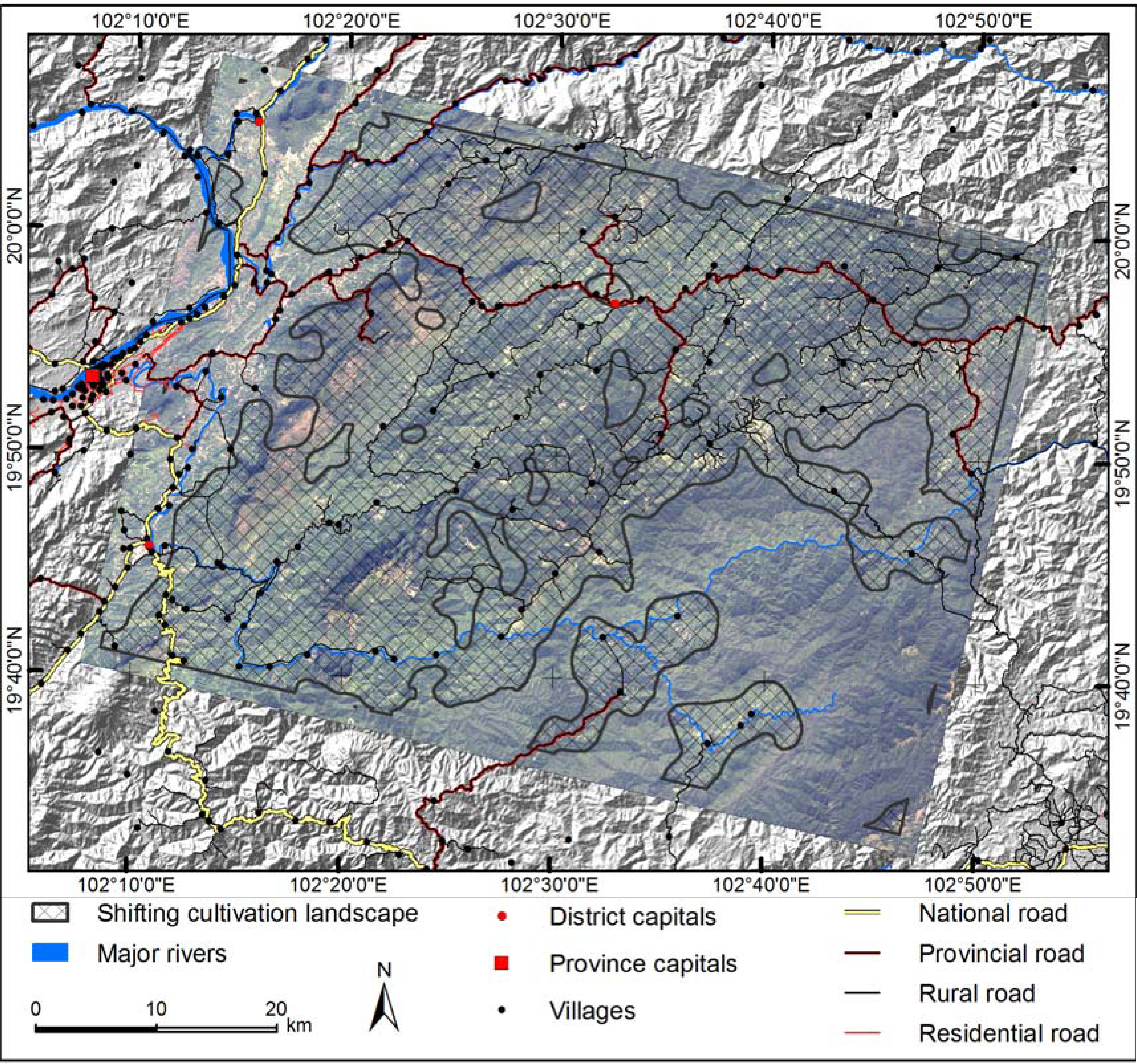
| Classification 1 | Classification 2 | |
|---|---|---|
| BA (bare areas) | 7.9% | 6.7% |
| GS (grassland/scrubland) | 39.7% | 24.9% |
| YF (young forest) | 20.2% | 34.6% |
| MF (mature forest) | 32.2% | 33.8% |
| Reference Class | |||||
|---|---|---|---|---|---|
| BA | GS | YF | MF | ||
| Classification | BA | 95.70 | 10.16 | 0.00 | 0.00 |
| GS | 4.30 | 84.82 | 73.26 | 19.74 | |
| YF | 0.00 | 5.02 | 26.74 | 7.43 | |
| MF | 0.00 | 0.00 | 0.00 | 72.83 | |
| Reference Class | |||||
|---|---|---|---|---|---|
| BA | GS | YF | MF | ||
| Classification | BA | 94.65 | 5.17 | 0.00 | 0.00 |
| GS | 5.35 | 94.83 | 24.73 | 0.00 | |
| YF | 0.00 | 0.00 | 75.27 | 6.61 | |
| MF | 0.00 | 0.00 | 0.00 | 93.39 | |
© 2013 by the authors; licensee MDPI, Basel, Switzerland This article is an open access article distributed under the terms and conditions of the Creative Commons Attribution license (http://creativecommons.org/licenses/by/3.0/).
Share and Cite
Hurni, K.; Hett, C.; Epprecht, M.; Messerli, P.; Heinimann, A. A Texture-Based Land Cover Classification for the Delineation of a Shifting Cultivation Landscape in the Lao PDR Using Landscape Metrics. Remote Sens. 2013, 5, 3377-3396. https://doi.org/10.3390/rs5073377
Hurni K, Hett C, Epprecht M, Messerli P, Heinimann A. A Texture-Based Land Cover Classification for the Delineation of a Shifting Cultivation Landscape in the Lao PDR Using Landscape Metrics. Remote Sensing. 2013; 5(7):3377-3396. https://doi.org/10.3390/rs5073377
Chicago/Turabian StyleHurni, Kaspar, Cornelia Hett, Michael Epprecht, Peter Messerli, and Andreas Heinimann. 2013. "A Texture-Based Land Cover Classification for the Delineation of a Shifting Cultivation Landscape in the Lao PDR Using Landscape Metrics" Remote Sensing 5, no. 7: 3377-3396. https://doi.org/10.3390/rs5073377






